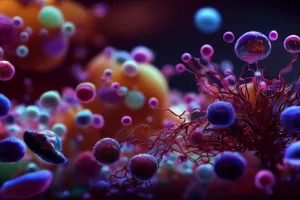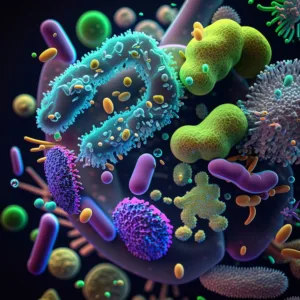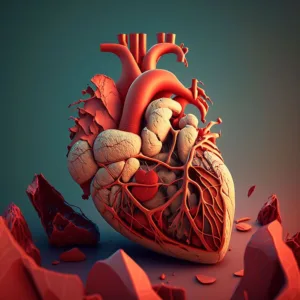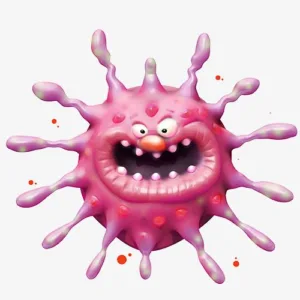How Bacteria Could Be the Next Antibiotics
How Bacteria Could Be the Next Antibiotics:
Exploring the Potential of Bacteriophage Therapy
Antibiotics have been hailed as one of the most significant medical advancements in history. These powerful medications have saved countless lives from bacterial infections and have been instrumental in modern medicine. However, with the rise of antibiotic-resistant bacteria, there is a pressing need for alternative treatments.
In recent years, scientists have been exploring the potential of bacteriophage therapy as a possible solution to this problem. Could bacteria be the next antibiotics? Let’s delve into the world of bacteriophages and their role in fighting bacterial infections.
What are Bacteriophages?
Bacteriophages, also known as phages, are viruses that specifically target and infect bacteria. They were first discovered in 1915 by Frederick Twort and later independently by Felix d’Herelle. These tiny viruses are abundant in nature and can be found in soil, water, and even inside our bodies.

image credit pinterest
Similar to how a virus infects a human cell, bacteriophages attach themselves to the surface of bacteria and inject their genetic material into them. This genetic material then takes control of the bacteria’s cellular machinery, replicating itself and eventually causing the bacteria to burst open, releasing more phages into the environment.
Bacteriophages have a high specificity for their target bacteria, meaning they only infect a particular strain or species. This specificity is one of their significant advantages over antibiotics, which can also kill beneficial bacteria in our bodies.
The Rise of Antibiotic Resistance
Antibiotic resistance occurs when bacteria mutate and develop resistance to antibiotics. This phenomenon has been on the rise for decades due to the overuse and misuse of antibiotics. When antibiotics are overprescribed or used unnecessarily, it provides an opportunity for bacteria to develop resistance.

image credit pinterest
According to the Centers for Disease Control and Prevention (CDC), at least 2.8 million people are infected with antibiotic-resistant bacteria each year, and over 35,000 people die as a result. It is a significant threat to public health, and if left unchecked, it could render our current antibiotics ineffective in the near future.
The Potential of Bacteriophage Therapy
Bacteriophages have been used for decades as an alternative to antibiotics in countries like Russia and Georgia. However, it has only recently gained attention in Western medicine as a potential solution to antibiotic resistance. With the rise of superbugs, scientists are now turning to bacteriophage therapy as a promising alternative.
One of the main advantages of using bacteriophages is their specificity. Unlike antibiotics, which can also kill beneficial bacteria in our bodies, bacteriophages only target the specific bacteria causing the infection. This targeted approach reduces the chances of developing resistance and also minimizes side effects.
Moreover, bacteriophages can be easily modified to target new strains of bacteria. As bacteria continue to evolve and develop resistance to antibiotics, scientists can modify bacteriophages to specifically target these new strains. This adaptability makes them an ideal solution for the ever-changing world of bacteria.

image credit pinterest
Now we will discuss about the differences between bacteria and viruses:
Understanding the Distinct Worlds of Bacteria and Viruses:
The microscopic world is teeming with diverse life forms, among which bacteria and viruses are paramount due to their profound impact on health, ecology, and biotechnology. Despite often being lumped together in the public consciousness, they are fundamentally different in structure, function, and interaction with living organisms.
Bacteria: The Pioneers of Life:
Bacteria are ancient, single-celled organisms with a rich history dating back billions of years. They are prokaryotes, meaning they lack a true nucleus and membrane-bound organelles. Their genetic material, typically a single circular chromosome, floats freely within the cell in a region called the nucleoid. Bacteria are incredibly versatile; they can be found in every conceivable environment, from the deepest ocean trenches to the highest mountain peaks, and even inside the human body.
Characteristics of Bacteria:
Cell Structure: Bacteria possess a rigid cell wall made of peptidoglycan, which maintains their shape and protects against external stress. Some bacteria also have a second outer membrane, making them more resistant to antibiotics.
Size: They are relatively large, ranging from 0.5 to 5 micrometers in length.
Reproduction: Bacteria reproduce asexually through binary fission, a process where one cell divides into two identical daughter cells.

image credit pinterest
Metabolism: They exhibit diverse metabolic capabilities, from photosynthesis to chemosynthesis, and can survive in both oxygen-rich and oxygen-poor environments.
Beneficial and Harmful Roles: Many bacteria are beneficial, playing crucial roles in processes like nitrogen fixation and decomposition. However, pathogenic bacteria can cause diseases such as pneumonia, tuberculosis, and cholera.
Viruses: The Enigmatic Entities
Viruses are much smaller than bacteria and exist on the borderline of what is considered ‘alive.’ They are essentially genetic material encased in a protein coat called a capsid, and sometimes an additional lipid envelope. Viruses lack the machinery for self-replication and must hijack a host cell’s apparatus to reproduce.

Virus
Characteristics of Viruses:
Size: Viruses are minuscule, typically ranging from 20 to 300 nanometers.
Structure: They contain either DNA or RNA, but not both, and the genetic material can be single or double-stranded.
Host Dependence: Viruses can only replicate within a living host cell, making them obligate intracellular parasites.
Disease: Viruses are responsible for a wide range of diseases, from the common cold to more severe illnesses like HIV/AIDS and COVID-19.
Treatment: Unlike bacteria, viruses are not susceptible to antibiotics. Antiviral drugs and vaccines are the primary means of combating viral infections.
Key Differences Between Bacteria and Viruses
1. Cellular Structure: Bacteria are complex, self-sufficient cells with all the necessary components for life. Viruses, on the other hand, are simple and require a host to carry out life processes.
2. Size: Bacteria are significantly larger than viruses.
3.Reproduction: Bacteria can reproduce on their own, while viruses need a host cell to replicate.
4.Treatment: Antibiotics can treat bacterial infections but are ineffective against viruses, which may be treated with antiviral drugs or prevented with vaccines.
The distinction between bacteria and viruses is crucial for understanding their roles in health and disease. Bacteria, as living organisms, have a cellular structure that allows them to thrive independently. Viruses, devoid of cellular complexity, are entirely dependent on a host for replication. These differences dictate how we approach the prevention and treatment of the diseases they cause.
Antibiotics are typically substances produced by bacteria and fungi that inhibit the growth of or kill other microorganisms. Here’s a brief description of some bacteria that are used to produce antibiotics:
Streptomyces: This genus of bacteria is the source of many antibiotics. For example:Chloramphenicol is produced by S. venezuelae and is used to treat a variety of infections, including meningitis and typhoid fever.Daptomycin, from S. roseosporus, is used for skin infections and certain blood infections.
Fosfomycin comes from S. fradiae and is used to treat bladder infections.Neomycin, also from S. fradiae, is used for a variety of infections and is often found in topical medications.Streptomycin, from S. griseus, was one of the first antibiotics discovered and is used to treat tuberculosis and plague.Tetracycline is produced by S. rimosus and S. aureofaciens and is used to treat a wide range of infections.
These bacteria produce antibiotics as secondary metabolites during their reproductive phase. The antibiotics they produce have been crucial in the treatment of various bacterial infections and have saved countless lives since their discovery.
If you’re interested in the mechanisms by which these antibiotics act, they can vary from inhibiting cell wall synthesis to disrupting protein synthesis or nucleic acid synthesis within the target bacteria, thereby stopping their growth or killing them.
Current Applications of Bacteriophage Therapy:
Currently, bacteriophage therapy is mainly used in treating bacterial infections that are resistant to antibiotics. It has shown success in treating infections caused by Clostridioides difficile, Staphylococcus aureus, and Pseudomonas aeruginosa, among others.
In 2019, a 15-year-old girl from the UK became the first person in the world to be treated with genetically engineered bacteriophages. She had been suffering from a severe case of drug-resistant Mycobacterium abscessus infection for over a year. After receiving the treatment, her infection was completely cleared within six months.

image credit pinterest
In another case, a patient with cystic fibrosis who had been infected with a multidrug-resistant Pseudomonas aeruginosa achieved complete remission after receiving bacteriophage therapy. These success stories highlight the potential of bacteriophage therapy in treating infections that are resistant to antibiotics.
Challenges and Limitations:
While bacteriophage therapy shows a lot of promise, there are still some challenges and limitations that need to be addressed. One of the main challenges is the lack of large-scale clinical studies to prove its effectiveness. Most of the studies conducted on bacteriophage therapy have been small-scale and limited to specific bacterial infections.
Additionally, there is also a lack of standardized protocols for producing and administering bacteriophages. Unlike antibiotics, which are mass-produced and readily available, finding and isolating specific phages for a particular bacterial infection can be time-consuming and challenging.
Furthermore, there are concerns about the safety and potential side effects of bacteriophages. As they are viruses, there is a fear that they could mutate and become harmful to humans. However, so far, there have been no reported cases of this happening.
More you may Like:
The Future of Bacteriophage Therapy:
Despite these challenges, the potential of bacteriophage therapy cannot be ignored. With the rise of antibiotic resistance and the limited new antibiotics being developed, we need alternative treatments to combat bacterial infections. Bacteriophages could be the answer.
In recent years, there has been an increase in research and investment in bacteriophage therapy. Pharmaceutical companies are beginning to take notice, with several companies now developing phage-based therapies for commercial use.
Moreover, advances in technology have made it easier to isolate and manipulate specific phages for targeted treatments. This allows for more targeted and effective treatments for bacterial infections.
In the future, we may even see personalized bacteriophage therapy, where doctors can prescribe specific phages tailored to an individual’s bacterial infection. This could greatly reduce the chances of developing resistance and improve treatment outcomes.
Conclusion:
Bacteriophage therapy has the potential to revolutionize the way we treat bacterial infections. With the rise of antibiotic resistance, it is essential to have alternative treatments that are effective and have fewer side effects. While there are still challenges and limitations to be addressed, the future of bacteriophage therapy looks promising.
As we continue to explore and harness the power of bacteriophages, we could eventually see bacteria being the next antibiotics. These tiny viruses could become a vital weapon in our fight against bacterial infections and save countless lives in the process.
Q: How could bacteria be the next antibiotics?
A: Bacteria have the potential to produce novel compounds with antibiotic properties, offering new solutions to combat antibiotic-resistant infections.
Q: What are antibiotic-resistant infections?
A: Antibiotic-resistant infections occur when bacteria evolve to withstand the effects of antibiotics, making them difficult or impossible to treat with conventional medications.
Q: How do bacteria produce antibiotics?
A: Bacteria naturally produce antibiotics as a defense mechanism to compete with other microorganisms for resources in their environment.
Q: What makes bacterial-produced antibiotics promising?
A: Bacterial-produced antibiotics have unique chemical structures that differ from those of traditional antibiotics, potentially overcoming existing resistance mechanisms.
Q: Are there examples of bacteria-derived antibiotics already in use?
A: Yes, some antibiotics, such as erythromycin and vancomycin, are derived from bacteria. However, researchers are exploring untapped bacterial sources for new antibiotic discovery.
Q: How do scientists identify bacteria with antibiotic-producing capabilities?
A: Scientists screen bacterial strains collected from diverse environments, such as soil or marine habitats, for their ability to inhibit the growth of pathogenic bacteria.
Q: What challenges do researchers face in harnessing bacteria as a source of antibiotics?
A: Challenges include identifying novel bacterial strains with potent antibiotic activity, optimizing antibiotic production, and ensuring safety and efficacy for human use.
Q: How do bacteria resist the effects of their own antibiotics?
A: Bacteria can possess resistance mechanisms, such as modifying or degrading antibiotics, pumping them out of their cells, or altering their target sites.
Q: What strategies are researchers exploring to overcome bacterial resistance to antibiotics?
A: Researchers are investigating combination therapies, adjuvants that enhance antibiotic activity, and alternative treatment approaches to combat bacterial resistance.
Q: Can bacteria-derived antibiotics be produced sustainably?
A: Yes, advances in biotechnology and fermentation techniques enable the sustainable production of bacterial-derived antibiotics on a large scale.
Q: What are the advantages of bacterial-derived antibiotics over synthetic compounds?
A: Bacterial-derived antibiotics often have complex chemical structures and diverse modes of action, potentially reducing the likelihood of resistance development.
Q: Are there risks associated with using bacterial-derived antibiotics?
A: Risks include potential side effects, allergic reactions, and the emergence of resistance if antibiotics are overused or misused.
Q: How do researchers ensure the safety and efficacy of bacterial-derived antibiotics?
A: Bacterial-derived antibiotics undergo rigorous testing in preclinical and clinical trials to evaluate their safety, efficacy, and pharmacokinetic properties.
Q: Can bacterial-derived antibiotics be used to treat a wide range of infections?
A: Yes, depending on their spectrum of activity and pharmacological properties, bacterial-derived antibiotics may be effective against various bacterial pathogens.
Q: How long does it typically take to develop a bacterial-derived antibiotic from discovery to market?
A: The drug development process can take many years, involving preclinical studies, clinical trials, regulatory approval, and commercialization efforts.
Q: Are there regulatory hurdles in bringing bacterial-derived antibiotics to market?
A: Yes, bacterial-derived antibiotics must meet stringent regulatory requirements for safety, efficacy, and quality before receiving approval for clinical use.
Q: How can the overuse of antibiotics impact the effectiveness of bacterial-derived antibiotics?
A: Overuse of antibiotics can promote the development of resistance, limiting the effectiveness of both traditional and bacterial-derived antibiotics.
Q: What role do interdisciplinary collaborations play in antibiotic discovery efforts?
A: Interdisciplinary collaborations involving microbiologists, chemists, pharmacologists, and clinicians are essential for advancing antibiotic discovery and development.
Q: How can individuals contribute to combating antibiotic resistance?
A: Individuals can help combat antibiotic resistance by using antibiotics responsibly, completing prescribed courses, supporting research efforts, and advocating for prudent antibiotic use policies.
More visit our another page:https://taazakhobor.in/
More you can read:
The Science of Laughter: How Humor Impacts Our Mental and Physical Health
How to start a gym business in 2024. The most profitable business. Don’t miss at all!!
How to lose weight in 3 months
Exploring Our Earth : Some unbelievable quick facts about our planet Earth.
Ancient Lost Languages of the world.





